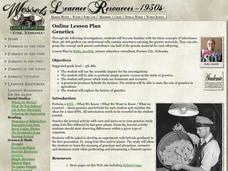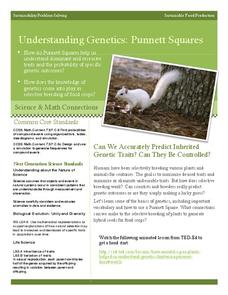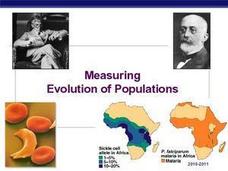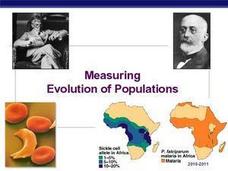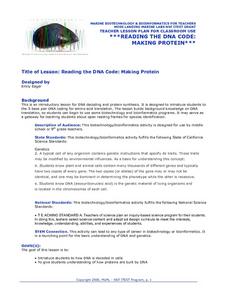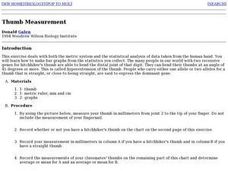Curated OER
Autosomal Pedigrees Worksheet
Three autosomal pedigrees are printed on this assignment. Biology scholars read them and determine the phenotypes for several individuals and find which ones inherit different genetic disorders. This fundamental skill can be reinforced...
Curated OER
Genetics and the Work of Mendel
Excellent examples and clear diagrams in this PowerPoint will help you explain the genetics of alleles and the combinations of hybrid crosses. A high school class would appreciate having this student copy of the PowerPoint as the images...
Curated OER
Genetics
Become familiar with the basic concepts of inheritance. Your junior high students work through mulitple examples of crosses and calculate probabilities of trait occurance. The explain the concept that each parent contributes one half of...
Curated OER
Genetics and The Work of Mendel
If you need a summary of all aspects of Mendelian genetics then this slideshow is for you. The information included is essential for complete understanding of crosses, genotypes, phenotypes, and heredity.
LABScI
Genetic Equilibrium: Human Diversity
Investigate the Hardy-Weinberg Principle to explain genetic equilibrium. The 10th lesson plan of a series of 12 is a laboratory exploration of genetic equilibrium. Your classes use a mixture of beans to model allele and genotype...
Curated OER
Stochastic and Deterministic Modeling
Explore the difference between stochastic and deterministic modeling through programming. First have the class write algorithms for relatively simple tasks using pseudocode. Use the Python 2.7 program app to simulate Mendel's Pea Pod...
Western Kentucky University
Understanding Genetics: Punnett Squares
Can scientists really predict genetic outcomes or are they simply making a lucky guess? Scholars first learn about Gregor Mendel and how to make Punnett squares. Then they extract DNA from a strawberry in a lab with included conclusion...
The Science Spot
Bikini Bottom Genetics 2
In this biology worksheet, learners use the information given on genetics, Sponge Bob and other characters to complete each of the questions on the sheet. They write the phenotype for each stated trait. Students also determine the...
Curated OER
Measuring Evolution of Populations
The Hardy-Weinberg principle is the focus of this concise slideshow. Some vocabulary definitions are given on the first 2 slides, and the rest are given over to examples of the Hardy-Weinberg theorem. Calculations of the H-W...
Curated OER
Measuring Evolution of Populations
The five agents of evolutionary change are reviewed in this slideshow. Definitions of common terms involved with populations and equilibrium are given, and there are some presentations of Hardy Weinberg equations for common examples of...
Curated OER
Recombination and Pedigrees
Biology aces answer four questions about genetic recombination and nine questions about pedigrees. This worksheet is very focused on these two topics. Most of the pedigree questions relate to the genetic disorders, Alkaptonuria and...
Curated OER
Reading the Dna Code: Making Protein
Students study DNA decoding and protein synthesis. They use the amino acid table to translate DNA, break DNA strands into three nucleotide codes, and translate nucleotides into amino acid protein codes. They research the importance of...
Cold Spring Harbor Laboratory
Mendelian Laws Apply to Human Beings
Why are so many inherited diseases more prevalent in populations of specified races? Scholars learn about pedigrees and genetics using a reading, an animation, primary sourced letters, a short video, a biography, a guided practice...
Cold Spring Harbor Laboratory
Mendelian Genetics Cannot Fully Explain Human Health and Behavior
The breakthrough of Mendelian genetics solved many puzzles for biologists. Then, scientists decided to apply the theory to human behavior. Learn the story and struggle of finding a genetic explanation for hobbies, interests, and mental...
Curated OER
Human Genetics
This is a worksheet regarding human genetics where students can poll the class regarding specific traits.
Curated OER
Using Blood Tests to Identify Babies and Criminals
Students solve a crime by matching a suspect's blood type to physical evidence collected at the crime scene. In this forensic science lesson, students identify the different blood types. They explain how blood tests work.
Curated OER
Nature vs. Nurture
Eighth graders investigate the concept of nature versus nurture in human development through this series of lessons.
Curated OER
Chapter Fourteen Questions: Human Genome
This multiple-choice and short-answer quiz covers chromosomes, genetic disorders, and more. The multiple choice section could work as a pretest, as well.
Curated OER
Hardy-Weinberg Equilibrium
Students investigate how Hardy-Weinberg Equilibrium is established and what assumptions and conditions are necessary to reach Equilibrium. They model alleles using materials such as index cards, M & M's and goldfish.
Curated OER
Inheritance Word Search Puzzle
In this literacy activity, students find the words that are related to the concept that is the theme of the word search puzzle.
Curated OER
How You Become a Unique Individual
Young scholars investigate how traits are passed from parents to offspring via meiosis and fertilization. They recognize that the combination of alleles forming a gamete is random.
Curated OER
The Genetic Basis of Neurological Disorders
Students describe some aspects of known genetic defects on the human neurological condition. They participate in a variety of exercises including drawings, games, and analogies.
Curated OER
Human Inheritance
Learners analyze genetic characteristics in a given family tree through the F2 generation. Students apply prior knowledge from Gregor Mendel's study with pea plants and his Laws of Heredity to answer questions.
Curated OER
Thumb Measurement
Pupils practice measuring using the metric system and millimeters. They measure their thumbs and record their findings. Students record the findings of their classmates and find the average or mean for the two groups.




